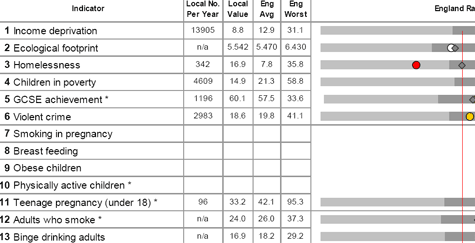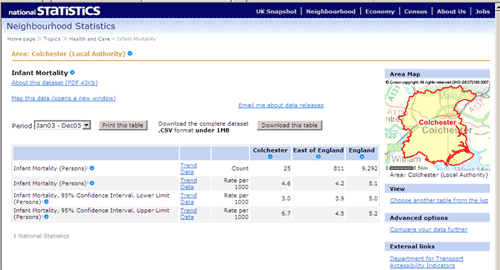Impact
Community profiling has become a staple activity of health authorities and primary care trusts. Policymakers are increasingly keen to judge policy interventions by their outcomes, and measuring changes in the demographic of the community that they are interested in is a key means of achieving this. Health care practitioners, too, are interested in the physical, social and economic make-up of the communities that they serve.
In general terms, a community profile might provide quantitative information on the following criteria for a defined local population:
- raw population numbers, broken down by age, sex, ethnicity, religion etc.
- vital statistics
- economic activity, employment
- housing, households
- crime statistics
- data on schools, educational attainment
- key health care indicators
However, whilst it is one thing to know what information is required in order to construct a community profile – and the list above is far from exhaustive – it is another thing to track that information down.
I’m interested in profiling Colchester Borough and comparing that profile to the Eastern Region and then to England. What do I do next?
Unfortunately, there is no single resource that can solve your problem at a stroke. That said, a useful first port of call would be the Other key data publishers at the bottom of the page. Because your focus is on Colchester and the Eastern Region it might be useful to start with the Colchester health profile, made available via Association of Public Health Observatories (APHO). From there, two mouse clicks take you to the Colchester profile.

Source: APHO and Department of Health. © Crown Copyright 2007
In fact, this profile might be all that is required as it sets the Colchester data in the context of the regional and England averages. Nevertheless, there is much more information available and a second resource that might be harvested is the online data browsing and analysis tool made available on the Eastern Region Public Health Observatory (ERPHO) web site.
The ERPHO data tool runs using Nesstar and can be used to extract a wealth of health-related indicators at ward, primary care trust (PCT), local authority (LA), strategic health authority (SHA) and regional level. Some indicators are available to internal staff only via authentication but most are freely available without the requirement to authenticate. Using the ERPHO data tool, information could be extracted on, amongst other things, population estimates/projections at county and SHA level; notifiable disease statistics for 1982-2005 for regions, counties and districts; and breast screening coverage at national, regional, SHA and primary care trust (PCT) level.
Of course, not all regional PHO web sites publish data in this way but most make localised health-related data available online in some form – return to Other key data publishers and click on the ‘data’ links below each of the regional PHO web sites.
Still focusing attention on access to local data, the National Statistics (NS) Neighbourhood Statistics resource can also be used. This resource allows the retrieval of a wide range of social and economic aggregate-level indicators for a number of different geographies, including: local authority, ward, PCT, health authority, education authority and parliamentary constituency. Requesting ‘Colchester’ and ‘Local Authority’ brings up a large choice of datasets to browse, including a number on ‘Health and Care’. Choosing ‘Infant Mortality’ from the list, calls up the page displayed below.

Source: Neighbourhood Statistics © Crown Copyright 2008
A key strength of the Neighbourhood Statistics resource is that it provides not only the figures for the focus of the community profile (in this case, Colchester) but also the comparative data for the region and nation.
Where else might I look for data?
The sources described above are probably the key ones but they are not the only places where a community profiler might search for data on the web. A selection of other useful sources of information would include:
